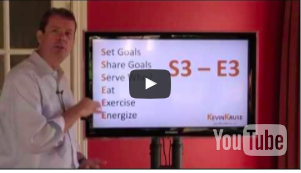
How do highly successful people get and stay motived? How do they tap endless reserves of energy and optimism, encouraging all those around them as well?
They say, “Success leaves clues” and I’ve had the opportunity to spend time with Marine Corps generals, Congressmen, Olympians, Fortune 500 CEOs and countless successful entrepreneurs. From my direct observations and interviews there are six keys to getting and staying motivated—three have to do with our minds, and three relate to our bodies. I use a simple mnemonic, S3-E3, to make these keys easier to remember.
S-Set Goals
The first “S” in the E3-S3 system stands for setting goals. “Yeah, yeah, I’ve heard this before,” you’re thinking. But what I have discovered is that SMART goals are D-U-M-B. The problem with the classic SMART goal acronym is the letter A which stands for Achievable. Small goals are not motivating. If you have trouble getting out of bed in the morning it isn’t because you’re lazy, it’s because your goals are too small.
Everyone I've spoken to who are really at the top of their field, they don't set obvious, achievable goals. They set gigantic goals. Think Elon Musk. His goals? Oh just little things like colonize Mars, create pollution free cars and of course there the hyperloop.
The business writer Jim Collins, he talks about businesses having a big hairy audacious goal. He calls it a B-HAG. The trick is to know how big to set it without making it so outlandish that you don't really think it's possible. Goal researchers say the bigger the goal the bigger our motivation and performance, right up until the point where we no longer think that that goal is even possible. At that point, our motivation drops off, falls off of a cliff because we just think it’s ridiculous.
So what’s your big audacious stretch goal?
S-Share Your Goals With The World
I'm not talking about the new age stuff where you just sort of declare your “intention” to the universe and then the universe will give it to you. Whether it's the amount of money in my bank account or my body weight I don't think the universe cares.
Sharing your goals publicly works for practical reasons. For example, I write books and for new launches I have a goal to get one hundred honest book reviews within one week. What I find is as I share this and other goals out with my friends and people in my online communities they'll say, “Oh I didn't know that mattered or that was important to you, I read your book and I loved it sure I'll go on Amazon and leave your review”.
If you share publicly that you've got a weight loss goal or fitness goal that you're trying to reach, your friends are going to be more likely to come over for the football game bringing carrots and celery rather than the nacho cheese sauce. Maybe they'll choose a slightly healthier restaurant when you all go out to lunch.
Announce your goals and resolutions to those around you, so they can be there to support and encourage you.
S-Serve Who?
The third S in the S3-E3 model is “serve who”. Who are you going to serve with your goal beyond yourself? This is you why behind the why. Everyone who consistently stays motivated and inspired over the long haul is really working for a higher purpose, for a cause greater than herself.
For example, let’s assume your goal is to quit smoking. A laudable goal. Why do you want quit? You’ll probably say because you don't want to die of cancer. That's a great answer. That's your first why. But what’s the why behind the why? As silly as it may sound, why do you want to not die of cancer? You might say, “Well I've got grandkids and I want to be around to see them grow up.” That’s your why behind the why. That’s who you are ultimately serving with that goal. Your grandkids will fuel your motivation.
E – Eat
The reality is that we live in our bodies, and if your body is tired, run down or sick, you will not be mentally motivated. So the first E in the S3-E3 motivation system stands for Eat.
Too often we starve our bodies by skipping meals or we poison ourselves with junk food. When I was starting my first companies—young and dumb in my twenties—I would wake up and jump out of bed motivated to hit the day. I’d just grab a coffee and skip breakfast thinking I'm saving calories. Then the next thing I’d know it'd be two o'clock in the afternoon, and I’m famished and losing focus. A quick slice of pizza and a soda and then back to work. Of course my carb coma kicked in about an hour later. Not a way to sustain our bodies, minds or motivation.
Everybody I know who maintain high energy levels throughout the day know that food is fuel. Instead of skipping meals they're mindfully eating five or six small meals throughout the day to keep their metabolism high and a steady stream of glucose pumping through the brain.
E – Exercise
The second E in the S3-E3 motivation system stands for Exercise. But don’t panic! I’m not talking about hardcore painful gym workouts. (If you are already doing your “WOD” at a local Crossfit box, good for you. And many of the most successful people I know do really rigorous workouts on a daily basis.)
Sitting is the new smoking and to keep your motivation high you need to move. Twenty minutes a day seems to be the magic number. Twenty minutes on the treadmill, twenty minutes of yoga, twenty minutes of brisk walking around the parking all work when it comes to breathing, blood circulation and feeling energized.
E – Energize (Energy management)
The final E is energize, or managing your energy. It begins with getting productive sleep. Yes, you should get 8’ish hours of sleep but I know that just isn’t realistic. But you can improve your deep sleep, your sleep quality. I interview 13 Olympic athletes about their productivity routines and almost all of them talked about the importance of downtime and sleep as “recovery”. Think of your bedroom as a sleep sanctuary. What can you do to make sure it’s as dark and quiet as possible?
Building on a foundation of sleep, we need to manage our daytime energy by working in cycles. If you work straight through without breaks, your body and mind both quickly weaken—often without you realizing it. Fatigue and lack of glucose impact our mood, not to mention decision making and willpower. Many people swear by the Pomodoro Technique, where you work for twenty five minutes in a focused way and then take a five minute break. Personally, I prefer working in 50 to 60-minute work sprints, followed by a 10-15 minute break.
To maintain your motivation, you need to manage your energy all throughout the day.
Tying It All Together
S3-E3: three S's for what we need to do for our minds, and three E's for what we do for our body. Set big hairy audacious goals and share them out with the world. You will find allies. Think about why you really want that goal. Then eat healthy meals throughout the day, generate positive emotion with 20 minutes or more of motion, and pulse on and pause in cycles through your day.
What tips do you have for getting and staying motivated? Let me know by leaving a comment below.
—
Download “How Millionaire’s Schedule Their Day: A 1-page Planning Tool” to double your productivity and stop feeling so overworked and overwhelmed. Kevin Kruse is a keynote speaker and the author of the bestselling book 15 Secrets Successful People Know About Time Management.
Originally published on Forbes.














